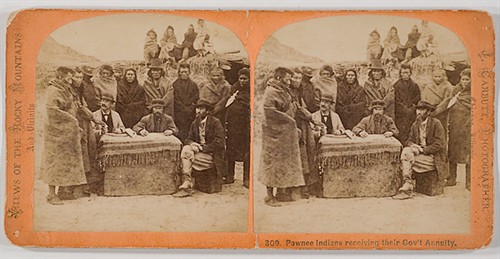The most
serious problem affecting Indian/white relations on the Great
Plains in the 1860s grew out of the failure of the annuity system -
an invention of the Great White Father. This 'tangled
consequence' of failed promises resulted from the vast number of
treaties struck with roaming tribes (for the acquisition of land)
throughout the 1850s.
The government
obtained title to these lands through Indian land cessions and
thereby assumed an obligation to provide compensation to the tribes
in the form of annuities. Since a reduced land base for the
Indians drastically reshaped their ability to sustain themselves by
the chase, the annuities were a critical component to
survival.

A stereopticon image of Pawnee Indians receiving
annuities guaranteed to them by treaty.
Following ratification of these
treaties by the U.S. Senate, the distribution of promised annuities
was the responsibility of officials of the Indian office.
Some historians have concluded that the tribes received no more
than half that was promised them. "The annuity system," wrote
Hiram Chittenden, 'probably gave rise to more abuses than any other
one thing in the conduct of Indian affairs."
In the summer
of 1864 as new wars broke out between whites and the plains tribes,
DeSmet saw the effects of this abuse first hand. As
explained by historian Hiram Chittenden, "The unhappy war
which is now raging so fiercely over all the extent of the Great
Desert, east of the Rocky Mountains, has, like so many other Indian
wars, been provoked by numerous injustices and misdeeds on the part
of the whites, and even of agents of the Government. For
years and years they have deceived the Indians with impunity in the
sale of their holdings of land, and afterward, by the embezzlement,
or rather the open theft, of immense sums paid them by the
government in exchange therefore."
S.J. Killoren
adds: "The sorry fact is that despite the ready promises given by
negotiators Mitchell and Fitzpatrick in 1851, Manypenny in 1853-54,
Cumming and Stevens in 1855, Carson, Bent, and agent Jesse
Leavenworth in 1865, the Indian Office made no plans and took no
steps to develop the capability of fulfilling such
commitments. There continued to be general disregard for the
1834 directive specifying on-site residence for each tribal agent,
who "shall not depart from the limits of his agency without
permission."
There were no
organized procedures for distributing annuities, and agents in
remote areas were without means of transportation, offices, or
abodes to store the annuities and supplies provided - this despite
the 1847 legislation which called for "Superintendents, agents, and
sub-agent" to be furnished with offices for the transaction of the
public business, and the agents and sub-agents with houses for
their residence."